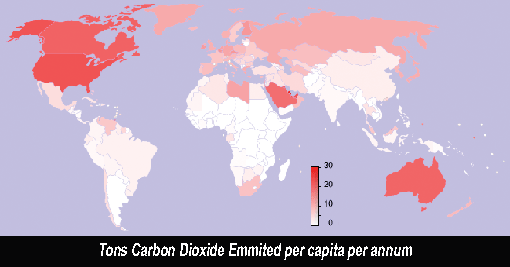 |
Articles
Greenhouse Gas.
We hear a lot about Greenhouse gas, but what is this? Why do these gases pose such a problem? Our atmosphere is a layer surrounding the earth held in place by gravity and primarily made up of Nitrogen (78%), Oxygen (21%), with water vapour and various gases making up the remainder.
It is on the 'remainder' that we will focus as it is the concentrations of these trace gases that cause the greenhouse gas problem. The trace gases are made up of Argon, Carbon Dioxide, Neon, Helium, Methane, Hydrogen, Nitrous Oxide and Ozone. (Follow the link to read more about the Ozone Hole) Human activities result in emissions of four principal greenhouse gases: carbon dioxide (CO2), methane (CH4), nitrous oxide (N2O) and the halocarbons (a group of gases containing fluorine, chlorine and bromine). All these gases have what is known as - Global Warming Potential , or GWP with some much higher than others.
Scientists now realise that the proportion of these gases has increased significantly over a few hundred years. The real increase began around the time of the Industrial Revolution. This is when we began to burn fossil fuels (coal) in large quantities to power our steam engines for industry, generate electricity, and heat our homes.
You can see from the graph below that carbon dioxide, nitrous oxide and methane have all increased significantly since the 1800s. Today the use of fossil fuel for power and electricity is thousands of times more than what it was in the 1800s.

CO2 CH4 N2O Greenhouse gas concentrations
The Greenhouse Blanket
Ok… You see how these gases have increased proportionally in our atmosphere, but perhaps you are thinking, so what?
To explain why these gases are termed greenhouse gases, we need to understand that during the day the earth absorbs heat from the sun, although much of this is radiated back out into space. The atmosphere surrounding our earth contains these gases, and acts like a blanket keeping some of the heat in. If there weren’t an atmospheric ‘blanket’ life may be impossible on Earth because everything would freeze at night, like some of the other planets or our moon.
This is where it gets a bit frightening! The fossil fuels we are burning in ever-increasing amounts contribute to higher concentrations of carbon dioxide, methane and nitrous dioxide (although oil reserves are running out ). These gases are called greenhouse gases because they effectively make the blanket around our globe thicker, trapping more heat and turning the globe into a green house.

global surface temperature
The Big Issue
The problem with humans contributing so much carbon dioxide is that Earth's natural system is overwhelmed and can't keep up with the rate of our CO2 release. The natural carbon cycle is disrupted and Earth's carbon 'sinks' or places that carbon can be safely absorbed are either diminishing or saturated.
We have coined the terms 'Global Warming' and 'Climate Change', to describe what is happening. Global economic growth is driving higher carbon dioxide emissions and we really must manage the tremendous amounts of carbon dioxide we are emitting.
The Carbon Cycle section explains in more detail what the carbon 'sinks' or reservoirs are. The concept of sinks is extremely important in understanding the nature of this problem.
Making a serious dent in our emissions will require a number of measures such as renewable energy targets, measures to support energy efficiency, addressing energy market failures through feed-in tariffs and the continued support for commercialisation of clean energy technologies.
Atmospheric pollution is also behind the idea of Global Dimming(which is not truly global). In this theory, the particulates emitted when burning fossil fuels could be shielding us from the full impact of global warming.
Greenhouse Gas Increasing
According to the US National Oceanic and Atmospheric Administration (NOAA), the amount of carbon dioxide (CO2) in the atmosphere increased by 19 billion tonnes in 2007. This is a rise of 0.6 per cent, lifting the concentration of the main greenhouse gas to 385 parts per million (ppm).
The measurements showed that levels of the second most abundant greenhouse gas, methane, jumped after being steady in recent years.
The rise in carbon dioxide from 280 ppm, along with increases in the other greenhouse gases, since the start of the Industrial Revolution is warming the planet changing our climate change beyond the natural cyclical variability.
The 2007 rise in global carbon dioxide is the third highest annual increase since atmospheric measurements began in 1958 and 20 per cent higher than the average of recent years.
The 19 billion tonne increase reflects an imbalance that has occurred in the planet’s carbon balance the net impact on atmospheric carbon dioxide from human and natural emissions on the one hand outweighing absorption from the air by oceans, vegetation and the soil. Since 2000, CO2 concentrations have been rising at 2 ppm every year compared to less than 1 ppm per year up to the 1960s.
Carbon Footprints
We all have a 'carbon footprint', which is a measure of the amount of carbon dioxide or CO2 emitted through the combustion of fossil fuels. This is directly related to the amount of natural resources consumed, and is increasingly used or referred to as a measure of environmental impact. The United States is certainly the biggest emitter, but with economies like China and India booming, the problem is set to expand exponentially. Below is a map showing tons of carbon dioxide emmited per country. How much carbon dioxide does your country contribute?
Global weather patterns are changing and greenhouse gas issues are affecting people... right now. You can make a difference, become informed, speak out, lobby politicians and get involved at a community level.

carbon dioxide footprint
|